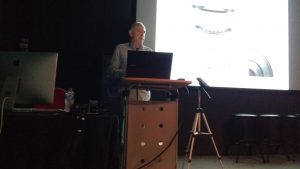Meeting Report
Sound delivery against the odds – the technical challenge
On Monday Feb 27th AES Melbourne members and gathered in the SAE Institute Lecture Theatre to hear Quests’ Frank Andrewartha speak on the topic “Sound delivery against the odds – the technical challenge”
Frank started out by describing the mechanics of the human hearing “circuit”. Then he played a video which demonstrated the hearing process through detailed animations.

He then briefly touched on sound reinforcement for public spaces such as railway stations, shopping centres, and airports where voice intelligibility for announcements is very important. He suggested that a well-designed system of sufficient ceiling speakers can adequately handle this task.
Moving on to performance venues, where full-range speech and music need to be amplified, he noted that this demand is much more difficult.
He first covered the difficulties imposed by reverberant field, and how to handle it by controlling the acoustic energy – keeping it away from the wrong places, and implementing a delayed system using fill speakers with the audio delayed to produce a coherent sound field. He then presented examples of systems, both big and small, utilizing delay speakers.
He then described setting the delay times, using the precedence (Haas) effect to align the acoustic image.
He went on to show some examples of difficult rooms, and techniques for improving intelligibility. He commented that intelligibility is not made with an eq, an audio processor, plug-ins, or corrective technologies. It comes, said Frank, from addressing the sound source, the problem being acoustic energy in the wrong time and place. He described the problems that were created when the traditional central clusters were replaced by stereo systems, which generated many more reflections off the walls and ceilings.
He then briefly described his technique of achieving asymmetrical distribution in the vocal range to better position the energy where it’s needed, and went on to describe the challenges in achieving this goal. He then described the operation of compression drivers, with particular emphasis on the phase plug, and diaphragm motion. Acoustic impedance matching was then described, and the importance of matching the driver design and horn design, and covered the use of waterfall plots as a design aid in developing his flares.
On digital processing, he commented that it has come a long way but it cannot make reverb go away, stop a resonant diaphragm from resonating, remove reflections from a ceiling, or stop a back wall slap-back. It can make a certain quantity of compensation, but it’s basically limited to camouflage. He then described how Quests’s asymmetrical projection system can move all the problems around, rather than solve them, He commented that other manufacturers had used this system before them, but had limited it to foldback boxes, and never expanded the concept to improving room intelligibility.
He concluded his presentation with details of a couple of installations, with details of the challenges faced in each case.
The evening concluded with a Q&A.
A video of the slides+audio is available:
This video can also be viewed directly on YouTube at:
https://www.youtube.com/watch?v=_Xcp1otGTZ8
A PDF copy of the slides presented can be viewed or downloaded here.
and
The audio-only recording can be heard or downloaded here.
A special thanks to the SAE Institute for the use of their excellent facilities.
